An Unexpected Discovery in Spynie Quarry, Elgin
Dave Longstaff, Elgin Museum Geology Group - as published in the 2022 Moray Field Club Bulletin
Spynie Quarry is situated a few miles north of Elgin and has been worked for around 150-200 years. Tennants (Elgin) Ltd. are the current licence holders and are crushing rock on-site to produce harling chips or building sand (Fig. 1).
The quarried stone comprises Late Triassic, cross-bedded, primarily aeolian sandstones with evidence of fluvial deposition near the base of the quarry (Fig. 2). The sandstones have yielded Triassic vertebrate and trace fossils, making them historically and paleontologically important. Reptile remains found at Spynie include Stagonolepis robertsoni and Hyperodapedon gordoni; these were first described by Huxley in 1859/60 and allowed the age of the sandstones to be determined. In the 1850s these rocks were thought to be Old Red Sandstone and thus match the outcrops found at Tarbat Ness on the other side of the Moray Firth.
Quarrying takes place by plucking rock downwards through the bedding planes; cross-bedding is rarely visible and although fracture surfaces can be seen, the walls generally display very few features.
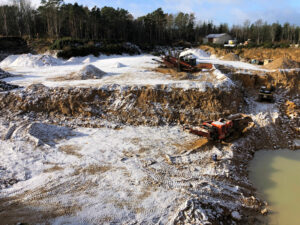
General view of Spynie Quarry. Recent quarrying downwards in a spiral fashion underneath original quarry floor.
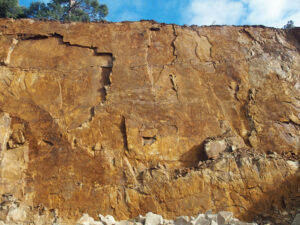
Fig. 2. Spynie Quarry Triassic aeolian sandstone. Note joints and fractures and horizontal bedding.
In the search for good quality rock, the quarrymen are currently working downwards, almost in a spiral fashion, and are excavating areas underneath the old quarry floor. Active quarrying brings with it the chance of new fossil finds and, in February 2022, Dave Longstaff from the Elgin Museum Geology Group was investigating a new rock exposure when his eye was drawn to a very unusual feature in a small, quarried wall (Fig. 3). The quarrymen had cut through a feature measuring about 7 m across, bounded on both sides by good quality sandstone and topped by a 30 cm layer of rubbly sandstone marking the old quarry floor. At the centre of the feature were stratified layers of rock very different to the normal quarried sandstone (Fig. 4). The stratified layers ~ 30 cm thick comprise small fragments of fractured mudstone interleaved with material resembling heavily decomposed rock, almost ash-like in composition (Fig. 5). These layers dip ~ 20˚ W while bedrock in this area dips ~ 10 ˚ NE. A face of one of the quarried blocks of sandstone (Fig.3.) showed what appeared to be a shallow channel and possible cross-bedding in the fractured mudstone (Fig. 6).
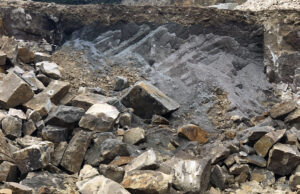
Fig. 3. 7 metre structure topped by rubble. Freshly quarried blocks below. Bedrock sandstone edge visible on right.
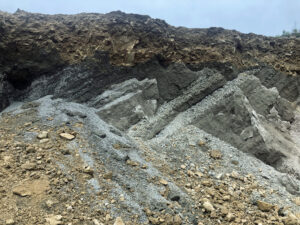
Fig. 4. Stratified infill of the feature. Rubbly, old quarry floor visible on top; fresh rubble below.
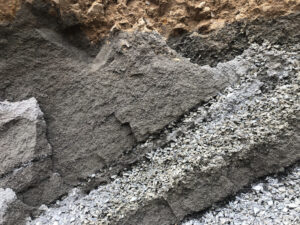
Fig. 5. Close up photograph of stratified layers of fractured mudstone and very fine-grained material. Rubble above.
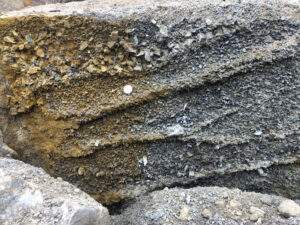
Fig. 6. Bottom of a quarried sandstone block. Small channel, above coin, and cross bedding?
After some thought, Dave concluded that the quarrying had uncovered a ‘fissure fill’ deposit; the structure was bounded by solid sandstone suggesting that there had been a failure on vertical fractures within the rock, creating a void which was subsequently infilled with the fractured mudstone and ash-like material. Fissure fill deposits in S Wales and SW England often contain fossils, indicating that this Spynie deposit could be highly significant. The stratification, with possible cross-beds and a channel evident on the quarried block, suggested that the material was deposited by running water but the stratification is across the void when water lain sediments should be coming towards the viewer. Dave considered that the void was curved, resulting in a dip to one side of the channel. Given that there are no similar mudstones locally that could account for the infill, this must simply be heavily decomposed rock.
On being sent the photographs above, colleagues agreed that it was a very unusual deposit but no further explanation was forthcoming. This led to another visit to the quarry the following day to see if any of the quarrymen could enlighten him; fortunately, the first person that Dave met was an older worker who had quarried the corner of interest the previous week. The quarryman agreed that the feature was unusual but said that he had been half-expecting to find it, making it increasingly unlikely that this was a fossil-filled fissure.
Years ago, the quarryman was told a story about an experiment that had taken place in Spynie quarry in the 1960s or 1970s when a construction company were considering including the stone in their asphalt making process. The company made a hole in the quarry floor ~ 7 m (25 feet) across in which to conduct their experiment but, when the results weren’t promising, the trial was ended. The sandstone proved to be too soft to be used as aggregate and the hole was backfilled. This process explains the ash-like decomposed rock in the stratified deposits and the burnt look to some of the rock near the hole as burning had taken place as part of the process. The quarry floor was subsequently reconstructed with rubble and thus lay there undisturbed for 50 years until quarrying from below the floor finally uncovered the forgotten structure. It’s not known how deep the hole was but the quarryman is as curious as Dave to find out more. The neat, methodical way in which the structure was backfilled is impressive and the story sheds some light on the area’s industrial history.
Permission for access must be obtained from the quarry operators, Tennants Ltd, Elgin, https://tennantselgin.com/
Remember to follow the Fossil Code: https://www.nature.scot/scottish-fossil-code.
All photographs © Dave Longstaff
Further reading:
- Benton, M.J. & Walker. A.D. 1984. Palaeocology, Taphonomy, and Dating of Permo-Triassic reptiles from Elgin, Northeast Scotland. Palaeontology, 28(2), 207-244
- Elgin Museum Geology Group & Mike Benton. 2021. The Elgin Reptiles. 54pp. Available from Elgin Museum (https://elginmuseum.org.uk/books/)
- Peacock, J.D. 1968. The Geology of the Elgin District (Explanation of One-inch Geological Sheet 95). Memoirs of the Geological Survey Scotland. H.M.S.O: Edinburgh. 165pp.
